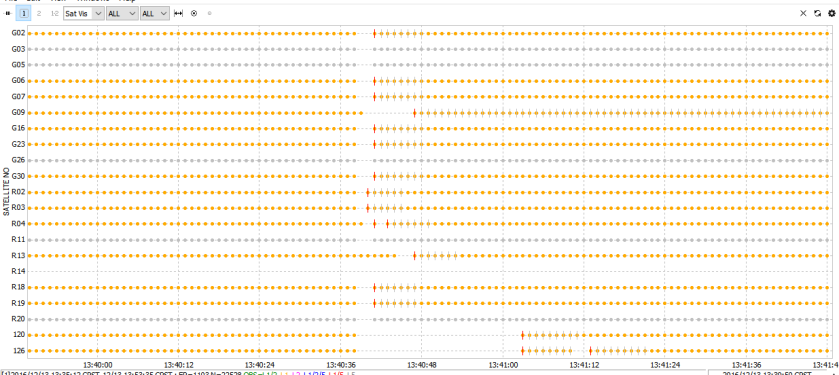I’ve described before the occasional glitches that both the M8N and M8T seem to be susceptible too in their first few minutes of operation, but my previous description was buried in one of my more technical posts and maybe not seen by people more interested in just the practical side of using RTKLIB, so I thought it was worth bringing them up again.
Here is an example of one of these glitches which was in a data set recently sent to me by a reader, and one that was giving him trouble finding a solution. The data is very clean, except for a nearly simultaneous cycle-slip (shown by red ticks) on every satellite.

Here is a zoomed in image of the same glitch.

I see these glitches on both the M8N and the M8T receivers. Every occurrence I have seen, the glitch occurred within a few minutes of turning on the receiver, and was present on every satellite. In this example it occurred seven minutes after starting up, usually I see it within in the first five minutes.
These glitches are very disruptive to the RTKLIB solution. Since the cycle-slips affect every satellite, all the phase-bias kalman filter states are reset and the solution has to start again from the beginning. In some cases, the phase-biases initial values may have larger than normal errors in which case it is even worse than starting over.
I don’t have any good suggestions on how to deal with these other than to avoid them in the first place. From my experience I believe they are more likely to occur if the external environment of the receiver has just changed. For example if it went from hot to cold, or into the sun. Once the receiver has had time to stabilize, everything is usually OK.
Giving the receiver time to adapt to it’s current environment before collecting data and protecting the receiver from sudden changes should help avoid these glitches. Using external antennas with cables rather than the small antennas that come with the receivers helps because it allows you to place the receiver in a more protected location than the antenna. For example, when I collect data from a moving car, I place the antenna on the roof but keep the receiver in the car.
For information on plotting the observations with cycle slip enabled see this post. For another post where I discuss this problem in more detail, see this post.
Does anyone else have more information on what causes these glitches and maybe other steps that can be taken to avoid or deal with them?

Not sure this has relevance but UBX-13003221-R11, page 21, Para 8.1 discusses Receiver Local Time and notes “As receiver local time is a mapping of the local 1 kHz reference onto a GNSS time-base, it may experience
occasional discontinuities, especially when the receiver first starts up and the information it has about the
time-base is changing.”
I have no idea if this has an effect on the geometry solution but it might be a factor since UBX-RNX-RAWX, pg. 309-315, references Receiver Local Time. Further Bitfield recStat (receiver tracking status bitfield) has a field clkReset indicating a clock reset applied.
LikeLike
Hi Bob. I think you may be right, or it may at least be part of the explanation. It’ll be interesting to see if the clkReset bit toggles during the “glitches”. If so it may help come up with a fix to allow RTKLIB to stay locked.
LikeLike
Some Trimbles have a flywheel mode in which the internal oscillator is left to drift. Clock disciplining can cause discontinuities if satellite visibility is poor. We saw lots of cycle slips with an antenna mounted on the inside of an airplane window.
LikeLike
My experience with Ublox receivers has been that the frequency source on-board is very very sensitive to temperature disturbance. Blowing a gentle breeze at a 7P is enough to throw the clock and clock rate biases into chaos, losing fix but not before emitting a few samples of absurd velocities. Ublox recommended potting the receiver or enclosing it in something airtight and relatively insulating to mitigate this.
LikeLike
Hi John. Do you have a link to this recommendation? I was interested in getting more details but couldn’t find a reference on the ublox site.
LikeLike
Thread is a bit old, but since I’ve recently encountered this issue…
This was recently added (rev.8, 28-May-2020) to the UBlox EVA-8M / M8 Hardware Integration Manual ( https://www.u-blox.com/en/docs/UBX-16010593 )
2.12 Layout design-in: Thermal management
During design-in do not place the module near sources of heating or cooling. The receiver oscillator is sensitive to sudden changes inambient temperature which can adversely impact satellite signal tracking.Sources can include co-located power devices, cooling fans or thermal conduction via the PCB.Take into account the following questions when designing in the module.:
– Is the receiverplaced away from heat sources?
– Is the receiver placed away from air-cooling sources?
– Is the receiver shielded by a cover/case to prevent the effects of air currents and rapidenvironmental temperature changes?
⚠High temperature drift and air vents can affect the GNSS performance. For best performance, avoid high temperature drift and air vents near the module.
This video shows the response pretty graphically:
LikeLike
Hi Mainr. Thanks, your video link demonstrate very effectively how temperature fluctuations can affect the TCXO!
LikeLike